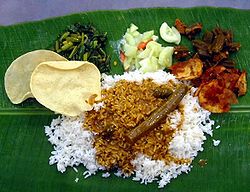Banana leaf rice is a traditional method of serving rice dishes in South Indian cuisine.[1]
Due to the migration of South Indians, banana leaf rice can also be
found in areas with significant ethnic South Indian diaspora like Malaysia and Singapore.
In banana leaf meals, white rice (or parboiled rice in authentic South Indian restaurants) is served on a banana leaf with an assortment of vegetables, pickles, papadum and other regional condiments (usually sour, salty and/or spicy). The banana leaf acts as a disposable plate and it in itself is not consumed. The choice of banana leaves is mainly due to the broad leaves as well as to the ubiquity of the plant in South India. Typically, only vegetarian gravy (e.g. sambar) will be served on the rice as it is meant to be a traditional vegetarian dish. However, sometimes boiled eggs, curried and/or fried meat or seafood are served as well. Traditionally there will be two servings of rice, with the first being served with gravy, side dishes and condiments whilst the second serving will be just rice with curd as a palate cleanser.
Banana leaf meals are eaten with hand. Banana leaf meal etiquette also dictates that, after the meal, the guest must always fold the banana leaf inwards as a sign of gratitude to the host, even when the host is the proprietor of an eatery. However, when meals are served at funeral wakes, the leaf is folded outwards as a sign of condolence to the family of the deceased. Due to this, folding the leaf outwards is considered rude in any other circumstance. In Malaysia, some Malaysians of non-Indian origin sometimes fold their banana leaf outward as a sign of dissatisfaction with an eatery's banana leaf meal. This is due to the erroneous belief that folding the leaf inwards or outwards is a way of rating the meal.
Banana Leaf Rice
In banana leaf meals, white rice (or parboiled rice in authentic South Indian restaurants) is served on a banana leaf with an assortment of vegetables, pickles, papadum and other regional condiments (usually sour, salty and/or spicy). The banana leaf acts as a disposable plate and it in itself is not consumed. The choice of banana leaves is mainly due to the broad leaves as well as to the ubiquity of the plant in South India. Typically, only vegetarian gravy (e.g. sambar) will be served on the rice as it is meant to be a traditional vegetarian dish. However, sometimes boiled eggs, curried and/or fried meat or seafood are served as well. Traditionally there will be two servings of rice, with the first being served with gravy, side dishes and condiments whilst the second serving will be just rice with curd as a palate cleanser.
Banana leaf meals are eaten with hand. Banana leaf meal etiquette also dictates that, after the meal, the guest must always fold the banana leaf inwards as a sign of gratitude to the host, even when the host is the proprietor of an eatery. However, when meals are served at funeral wakes, the leaf is folded outwards as a sign of condolence to the family of the deceased. Due to this, folding the leaf outwards is considered rude in any other circumstance. In Malaysia, some Malaysians of non-Indian origin sometimes fold their banana leaf outward as a sign of dissatisfaction with an eatery's banana leaf meal. This is due to the erroneous belief that folding the leaf inwards or outwards is a way of rating the meal.
Banana Leaf Rice
 RSS Feed
RSS Feed Twitter
Twitter 09:16
09:16
 Unknown
Unknown

0 comments:
Post a Comment